Cantonese cuisine
This article needs additional citations for verification. (September 2024) |
| Cantonese cuisine | |||||||||||||||||||||||
|---|---|---|---|---|---|---|---|---|---|---|---|---|---|---|---|---|---|---|---|---|---|---|---|
 Chefs cook with a wok | |||||||||||||||||||||||
| Traditional Chinese | 廣東菜 | ||||||||||||||||||||||
| Simplified Chinese | 广东菜 | ||||||||||||||||||||||
| Jyutping | Gwong2 dung1 coi3 | ||||||||||||||||||||||
| Cantonese Yale | Gwóng dūng choi | ||||||||||||||||||||||
| |||||||||||||||||||||||
| Yue cuisine | |||||||||||||||||||||||
| Traditional Chinese | 粵菜 | ||||||||||||||||||||||
| Simplified Chinese | 粤菜 | ||||||||||||||||||||||
| Jyutping | Jyut6 coi3 | ||||||||||||||||||||||
| Cantonese Yale | Yuht choi | ||||||||||||||||||||||
| |||||||||||||||||||||||
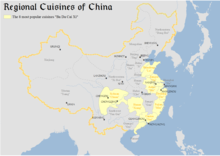
Cantonese or Guangdong cuisine, also known as Yue cuisine (Chinese: 廣東菜 or 粵菜), is the cuisine of Guangdong province of China, particularly the provincial capital Guangzhou, and the surrounding regions in the Pearl River Delta including Hong Kong and Macau.[1] Strictly speaking, Cantonese cuisine is the cuisine of Guangzhou or of Cantonese speakers, but it often includes the cooking styles of all the speakers of Yue Chinese languages in Guangdong.
The Teochew cuisine and Hakka cuisine of Guangdong are considered their own styles. However, scholars may categorize Guangdong cuisine into three major groups based on the region's dialect: Cantonese, Hakka and Chaozhou cuisines.[2] Neighboring Guangxi's cuisine is also considered separate despite eastern Guangxi being considered culturally Cantonese due to the presence of ethnic Zhuang influences in the rest of the province.
Cantonese cuisine is one of the Eight Great Traditions of Chinese cuisine. Its prominence outside China is due to the large number of Cantonese emigrants. Chefs trained in Cantonese cuisine are highly sought after throughout China.[3] Until the late 20th century, most Chinese restaurants in the West served largely Cantonese dishes.
Background
[edit]| Part of a series on |
| Chinese cuisine |
|---|
 |
Guangzhou (Canton) City, the provincial capital of Guangdong and the centre of Cantonese culture, has long been a trading hub and many imported foods and ingredients are used in Cantonese cuisine. Besides pork, beef and chicken, Cantonese cuisine incorporates almost all edible meats, including offal, chicken feet, duck's tongue, frog legs, snakes and snails.[citation needed] However, lamb and goat are less commonly used than in the cuisines of northern or western China. Many cooking methods are used, with steaming and stir-frying being the most favoured due to their convenience and rapidity. Other techniques include shallow frying, double steaming, braising and deep frying.
Compared to other Chinese regional cuisines, the flavours of most traditional Cantonese dishes should be well-balanced and not greasy. Apart from that, spices should be used in modest amounts to avoid overwhelming the flavours of the primary ingredients, and these ingredients in turn should be at the peak of their freshness and quality.[4] There is no widespread use of fresh herbs in Cantonese cooking, in contrast with their liberal use in other cuisines such as Sichuanese, Vietnamese, Lao, Thai and European. Garlic chives and coriander leaves are notable exceptions, although the former are often used as a vegetable and the latter are usually used as mere garnish in most dishes.
Foods
[edit]Sauces and condiments
[edit]In Cantonese cuisine, ingredients such as sugar, salt, soy sauce, rice wine, corn starch, vinegar, scallion and sesame oil suffice to enhance flavour, although garlic is heavily used in some dishes, especially those in which internal organs, such as entrails, may emit unpleasant odours. Ginger, chili peppers, five-spice powder, powdered black pepper, star anise and a few other spices are also used, but often sparingly.
| English | Traditional Chinese | Simplified Chinese | Jyutping | Pinyin |
|---|---|---|---|---|
| Black bean sauce | 蒜蓉豆豉醬 | 蒜蓉豆豉酱 | syun3 jung4 dau6 si6 zoeng3 | suànróng dòuchǐjiàng |
| Char siu sauce | 叉燒醬 | 叉烧酱 | caa1 siu1 zoeng3 | chāshāojiàng |
| Chu hau paste | 柱侯醬 | 柱侯酱 | cyu5 hau4 zoeng3 | zhùhóujiàng |
| Hoisin sauce | 海鮮醬 | 海鲜酱 | hoi2 sin1 zoeng3 | hǎixiānjiàng |
| Master stock | 滷水 | 卤水 | lou5 seoi2 | lǔshuǐ |
| Oyster sauce | 蠔油 | 蚝油 | hou4 jau4 | háoyóu |
| Plum sauce | 蘇梅醬 | 苏梅酱 | syun1 mui4 zoeng3 | sūméijiàng |
| Red vinegar | 大紅浙醋 | 大红浙醋 | daai6 hung4 zit3 cou3 | dàhóngzhècù |
| Shrimp paste | 鹹蝦醬 | 咸虾酱 | haam4 haa1 zoeng3 | xiánxiājiàng |
| Sweet and sour sauce | 糖醋醬 | 糖醋酱 | tong4 cou3 zoeng3 | tángcùjiàng |
-
Oysters steamed in two ways: with ginger and garlic, and in black bean sauce
Dried and preserved ingredients
[edit]Although Cantonese cooks pay much attention to the freshness of their primary ingredients, Cantonese cuisine also uses a long list of preserved food items to add flavour to a dish. This may be influenced by Hakka cuisine, since the Hakkas were once a dominant group occupying imperial Hong Kong and other southern territories.
Some items gain very intense flavours during the drying/preservation/oxidation process and some foods are preserved to increase their shelf life. Some chefs combine both dried and fresh varieties of the same items in a dish. Dried items are usually soaked in water to rehydrate before cooking. These ingredients are generally not served a la carte, but rather with vegetables or other Cantonese dishes.
| Image | English | Traditional Chinese | Simplified Chinese | Jyutping | Pinyin | Notes |
|---|---|---|---|---|---|---|
 |
Century egg | 皮蛋 | pei4 daan2 | pídàn | Can be found served with roasted dishes, in congee with lean pork, and in a sweet pastry with lotus paste. | |
 |
Chinese sausage | 臘腸 | 腊肠 | laap6 coeng2 | làcháng | Usually added to rice together with preserved-salted duck and pork. |
 |
Dried cabbage | 菜乾 | 菜干 | coi3 gon1 | càigān | |
 |
Dried scallops | 江珧柱 | gong1 jiu4 cyu5 | jiāngyáozhù | Usually added to clear soup. | |
| 江瑤柱 | 江瑶柱 | |||||
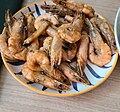 |
Dried shrimp | 蝦乾 | 虾干 | haa1 gon1 | xiāgān | Usually de-shelled, sliced into half and added to vegetable dishes. |
 |
Dried small shrimp | 蝦米 | 虾米 | haa1 mai5 | xiāmǐ | Usually mixed with stir-fried vegetables. |
 |
Fermented tofu | 腐乳 | fu6 jyu5 | fǔrǔ | ||
 |
Fermented black beans | 豆豉 | dau6 si6 | dòuchǐ | Usually added to pork and tofu dishes. | |
 |
Pickled Chinese cabbage | 梅菜 | mui4 coi3 | méicài | Usually cooked with pork or stir-fried with rice. | |
 |
Pickled diced radish | 菜脯 | coi3 pou2 | càifǔ | ||
 |
Preserved-salted duck | 臘鴨 | 腊鸭 | laap6 aap2 | làyā | Usually eaten with rice in a family meal. |
 |
Preserved-salted pork | 臘肉 | 腊肉 | laap6 juk6 | làròu | Usually eaten with rice in a family meal. |
 |
Salted duck egg | 鹹蛋 | 咸蛋 | haam4 daan2 | xiándàn | May be eaten as it is or mixed with stir-fried vegetables and steam dishes or cooked with diced pork in congee. |
 |
Salted fish | 鹹魚 | 咸鱼 | haam4 jyu2 | xiányú | Usually paired with steamed pork or added to fried rice together with diced chicken. |
 |
Suan cai | 鹹酸菜 | 咸酸菜 | haam4 syun1 coi3 | xiánsuāncài | |
 |
Tofu skin | 腐皮 | fu6 pei4 | fǔpí | Usually used as wrapping for ground pork dishes. It is fried in a similar manner as spring rolls. | |
Traditional dishes
[edit]A number of dishes have been part of Cantonese cuisine since the earliest territorial establishments of Guangdong. While many of these are on the menus of typical Cantonese restaurants, some simpler ones are more commonly found in Cantonese homes. Home-made Cantonese dishes are usually served with plain white rice.
| Name | Image | Traditional Chinese | Simplified Chinese | Jyutping | Pinyin |
|---|---|---|---|---|---|
| Cantonese style fried rice |  |
廣式炒飯 | 广式炒饭 | gwong2 sik1 cau2 faan6 | guǎng shì chǎofàn |
| Choy sum in oyster sauce |  |
蠔油菜心 | 蚝油菜心 | hou4 jau4 coi3 sam1 | háoyóu càixīn |
| Congee with lean pork and century egg | 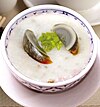 |
皮蛋瘦肉粥 | pei4 daan2 sau3 juk6 zuk1 | pídàn shòuròuzhōu | |
| Steamed egg |  |
蒸水蛋 | zing1 seoi2 daan2 | zhēngshuǐdàn | |
| Steamed frog legs on lotus leaf | 荷葉蒸田雞 | 荷叶蒸田鸡 | ho4 jip6 zing1 tin4 gai1 | héyè zhēng tiánjī | |
| Steamed ground pork with salted duck egg |  |
鹹蛋蒸肉餅 | 咸蛋蒸肉饼 | haam4 daan2 zing1 juk6 beng2 | xiándàn zhēng ròubǐng |
| Steamed spare ribs with fermented black beans and chilli pepper |  |
豉椒排骨 | si6 ziu1 paai4 gwat1 | chǐjiāo páigǔ | |
| Stewed beef brisket |  |
柱侯牛腩 | cyu5 hau4 ngau4 naam5 | zhùhóu niú nǎn | |
| Stir-fried hairy gourd with dried shrimp and cellophane noodles | 大姨媽嫁女 | 大姨妈嫁女 | daai6 ji4 maa1 gaa3 neoi5 | dàyímā jiànǚ | |
| Stir-fried water spinach with shredded chilli and fermented tofu |  |
椒絲腐乳通菜 | 椒丝腐乳通菜 | ziu1 si1 fu6 jyu5 tung1 coi3 | jiāosī fǔrǔ tōngcài |
| Sweet and sour pork |  |
咕嚕肉 | 咕噜肉 | gu1 lou1 juk6 | gūlūròu |
| Shunde-style fish slices[5] |  |
順德魚生 | 顺德鱼生 | seon6 dak1 jyu4 saang1 | shùndé yú shēng |
Deep fried dishes
[edit]There are a small number of deep-fried dishes in Cantonese cuisine, which can often be found as street food. They have been extensively documented in colonial Hong Kong records of the 19th and 20th centuries. A few are synonymous with Cantonese breakfast and lunch,[6] even though these are also part of other cuisines.
| English | Image | Traditional Chinese | Simplified Chinese | Jyutping | Pinyin |
|---|---|---|---|---|---|
| Dace fish balls |  |
鯪魚球 | 鲮鱼球 | leng4 jyu4 kau4 | língyúqiú |
| Chinese Donut |  |
油炸鬼 | jau4 zaa3 gwai2 | yóuzháguǐ | |
| Zaa Leung |  |
炸兩 | 炸两 | zaa3 loeng5 | zháliǎng |
Soups
[edit]Old fire soup, or lou fo tong (老火汤; 老火湯; lǎohuǒ tāng; lou5 fo2 tong; 'old fire-cooked soup'), is a clear broth prepared by simmering meat and other ingredients over a low heat for several hours. Chinese herbs are often used as ingredients. There are basically two ways to make old fire soup – put ingredients and water in the pot and heat it directly on fire, which is called bou tong (煲汤; 煲湯; bāo tāng; bou1 tong1); or put the ingredients in a small stew pot, and put it in a bigger pot filled with water, then heat the bigger pot on fire directly, which is called dun tong (燉汤; 燉湯; dùn tāng; dan6 tong1). The latter way can keep the most original taste of the soup.
Soup chain stores or delivery outlets in cities with significant Cantonese populations, such as Hong Kong, serve this dish due to the long preparation time required of slow-simmered soup.
| English | Traditional Chinese | Simplified Chinese | Jyutping | Pinyin |
|---|---|---|---|---|
| Cantonese seafood soup | 海皇羹 | hoi2 wong4 gang1 | hǎihuáng gēng | |
| Night-blooming cereus soup | 霸王花煲湯 | 霸王花煲汤 | baa3 wong4 faa1 bou1 tong1 | bàwánghuā bāotāng |
| Snow fungus soup | 銀耳湯 | 银耳汤 | ngan4 ji5 tong1 | yín'ěr tāng |
| Spare ribs soup with watercress and apricot kernels | 南北杏西洋菜豬骨湯 | 南北杏西洋菜猪骨汤 | naam4 bak1 hang6 sai1 joeng4 coi3 zyu1 gwat1 tong1 | nánběixìng xīyángcài zhūgǔ tāng |
| Winter melon soup | 冬瓜湯 | 冬瓜汤 | dung1 gwaa1 tong1 | dōngguā tāng |
Seafood
[edit]
Due to Guangdong's location along the South China Sea coast, fresh seafood is prominent in Cantonese cuisine, and many Cantonese restaurants keep aquariums or seafood tanks on the premises. In Cantonese cuisine, as in cuisines from other parts of Asia, if seafood has a repugnant odour, strong spices and marinating juices are added; the freshest seafood is odourless and, in Cantonese culinary arts, is best cooked by steaming. For instance, in some recipes, only a small amount of soy sauce, ginger and spring onion is added to steamed fish. In Cantonese cuisine, the light seasoning is used only to bring out the natural sweetness of the seafood. As a rule of thumb, the spiciness of a dish is usually negatively correlated to the freshness of the ingredients.
| Image | English | Traditional Chinese | Simplified Chinese | Jyutping | Pinyin |
|---|---|---|---|---|---|
 |
Lobster with ginger and scallions | 薑蔥龍蝦 | 薑葱龙虾 | goeng1 cung1 lung4 haa1 | jiāngcōng lóngxiā |
 |
Mantis shrimp | 攋尿蝦 | 濑尿虾 | laai6 niu6 haa1 | làniàoxiā |
 |
Steamed fish | 蒸魚 | 蒸鱼 | zing1 yu4 | zhēngyú |
 |
Steamed scallops with ginger and garlic | 蒜茸蒸扇貝 | 蒜茸蒸扇贝 | syun3 jung4 zing1 sin3 bui3 | suànróng zhēng shànbèi |
 |
White boiled shrimp | 白灼蝦 | 白灼虾 | baak6 zoek3 haa1 | báizhuóxiā |
-
Typical ingredients for Cantonese style hotpot are razor shell (蟶子), crab (蟹), prawn (蝦), chicken sausage (雞肉腸仔) and dace fishball (魚旦)
Noodle dishes
[edit]Noodles are served either in soup broth or fried. These are available as home-cooked meals, on dim sum side menus, or as street food at dai pai dongs, where they can be served with a variety of toppings such as fish balls, beef balls, or fish slices.
| English | Image | Traditional Chinese | Simplified Chinese | Jyutping | Pinyin | Notes |
|---|---|---|---|---|---|---|
| Beef brisket noodles |  |
牛腩麵 | 牛腩面 | ngau4 laam5 min6 | niú nǎn miàn | May be served dry or in soup. |
| Beef chow fun |  |
乾炒牛河 | 干炒牛河 | gon1 caau2 ngau4 ho2 | gān chǎo niú hé | |
| Chow mein |  |
炒麵 | 炒面 | caau2 min6 | chǎo miàn | A generic term for various stir-fried noodle dishes. Hong Kong-style chow mein is made from pan-fried thin crispy noodles. |
| Jook-sing noodles | 竹昇麵 | 竹升面 | zuk1 sing1 min6 | zhúshēngmiàn | Bamboo log pressed noodles. | |
| Lo mein |  |
撈麵 | 捞面 | lou1 min6 | lāo miàn | |
| Rice noodle roll |  |
腸粉 | 肠粉 | coeng2 fan2 | chángfěn | Also known as chee cheong fun. |
| Rice noodles |  |
河粉 | ho4 fun2 | héfěn | Also known as hor-fun. | |
| Silver needle noodles |  |
銀針粉 | 银针粉 | ngan4 zam1 fun2 | yín zhēn fěn | Also known as rat noodles (老鼠粉; lǎoshǔ fěn; lou5 syu2 fan2). |
| Yi mein |  |
伊麵 | 伊面 | ji1 min6 | yī miàn | Also known as e-fu noodles. |
| Wonton noodles |  |
雲吞麵 | 云吞面 | wan4 tan1 min6 | yúntūn miàn | Sometimes spelled as wanton noodles. |
Siu mei
[edit]
Siu mei (烧味; 燒味; shāo wèi; siu1 mei6) is essentially the Chinese rotisserie style of cooking. Unlike most other Cantonese dishes, siu mei solely consists of meat, with no vegetables.
| English | Image | Traditional Chinese | Simplified Chinese | Jyutping | Pinyin |
|---|---|---|---|---|---|
| Char siu |  |
叉燒 | 叉烧 | caa1 siu1 | chāshāo |
| Roast duck |  |
燒鴨 | 烧鸭 | siu1 aap3 | shāoyā |
| Roast goose |  |
燒鵝 | 烧鹅 | siu1 ngo4 | shāo'é |
| Roast pig |  |
燒肉 | 烧肉 | siu1 yuk1 | shāoròu |
| Roast pigeon |  |
燒乳鴿 | 烧乳鸽 | siu1 jyu5 gap3 | shāorǔgē |
Lou mei
[edit]Lou mei (卤味; 滷味; lǔ wèi; lou5 mei6) is the name given to dishes made from internal organs, entrails and other left-over parts of animals. It is widely available in southern Chinese regions.
| Image | English | Traditional Chinese | Simplified Chinese | Jyutping | Pinyin |
|---|---|---|---|---|---|
 |
Beef entrails | 牛雜 | 牛杂 | ngau4 zaap6 | niú zá |
 |
Beef brisket | 牛腩 | ngau4 laam5 | niú nǎn | |
 |
Chicken scraps | 雞雜 | 鸡杂 | gai1 zaap6 | jī zá |
| Duck gizzard | 鴨腎 | 鸭肾 | aap3 san6 | yā shèn | |
 |
Pig's tongue | 豬脷 | 猪脷 | zyu1 lei6 | zhū lì |
Siu laap
[edit]
All Cantonese-style cooked meats, including siu mei, lou mei and preserved meat can be classified as siu laap (烧腊; 燒臘; shāo là; siu1 laap6). Siu laap also includes dishes such as:
| English | Image | Traditional Chinese | Simplified Chinese | Jyutping | Pinyin | Notes |
|---|---|---|---|---|---|---|
| Chicken in soy sauce |  |
豉油雞 | 豉油鸡 | si6 jau4 gai1 | chǐ yóu jī | |
| Orange cuttlefish |  |
鹵水墨魚 | 卤水墨鱼 | lou5 seoi2 mak6 jyu4 | lǔshuǐ mòyú | |
| Poached duck in master stock | 滷水鴨 | 卤水鸭 | lou5 seoi2 aap3 | lǔ shuǐ yā | ||
| White cut chicken |  |
白切雞 | 白切鸡 | baak6 cit3 gai1 | bái qiè jī | Also known as white chopped chicken (白斩鸡; 白斬雞; báizhǎnjī; baak6 zaam2 gai1) in some places. |
A typical dish may consist of offal and half an order of multiple varieties of roasted meat. The majority of siu laap is white meat.
| English | Image | Traditional Chinese | Simplified Chinese | Jyutping | Pinyin |
|---|---|---|---|---|---|
| Rice with Chinese sausage and char siu |  |
臘腸叉燒飯 | 腊肠叉烧饭 | laap6 ceung4 caa1 siu1 faan6 | làcháng chāshāo fàn |
| Rice with roast goose and goose intestines | 燒鵝鵝腸飯 | 烧鹅鹅肠饭 | siu1 ngo4 ngo4 coeng4 faan6 | shāo é é cháng fàn | |
| Siu mei platter |  |
燒味拼盤 | 烧味拼盘 | siu1 mei6 ping6 poon4 | shāowèi pīnpán |
| Siu lap platter |  |
燒臘拼盤 | 烧腊拼盘 | siu1 laap6 ping6 pun4 | shāolà pīnpán |
Little pot rice
[edit]
Little pot rice (煲仔饭; 煲仔飯; bāozǎifàn; bou1 zai2 faan6) are dishes cooked and served in a flat-bottomed pot (as opposed to a round-bottomed wok). Usually this is a saucepan or braising pan (see clay pot cooking). Such dishes are cooked by covering and steaming, making the rice and ingredients very hot and soft. Usually the ingredients are layered on top of the rice with little or no mixing in between. Many standard combinations exist.
| English | Traditional Chinese | Simplified Chinese | Jyutping | Pinyin |
|---|---|---|---|---|
| Rice with Chinese sausage and preserved meat | 臘味煲仔飯 | 腊味煲仔饭 | laap6 coeng2 bou1 zai2 faan6 | làwèi bāozǎifàn |
| Rice with layered egg and beef | 窩蛋牛肉飯 | 窝蛋牛肉饭 | wo1 daan2 ngaw4 juk6 faan6 | wōdàn niúròu fàn |
| Rice with minced beef patty | 肉餅煲仔飯 | 肉饼煲仔饭 | juk6 beng2 bou1 zai2 faan6 | ròubǐng bāozǎifàn |
| Rice with spare ribs | 排骨煲仔飯 | 排骨煲仔饭 | paai4 gwat1 bou1 zai2 faan6 | páigǔ bāozǎifàn |
| Rice with steamed chicken | 蒸雞肉煲仔飯 | 蒸鸡肉煲仔饭 | zing1 gai1 juk6 bou1 zai2 faan6 | zhēng jīròu bāozǎifàn |
Banquet/dinner dishes
[edit]A number of dishes are traditionally served in Cantonese restaurants only at dinner time. Dim sum restaurants stop serving bamboo-basket dishes after the yum cha period (equivalent to afternoon tea) and begin offering an entirely different menu in the evening. Some dishes are standard while others are regional. Some are customised for special purposes such as Chinese marriages or banquets. Salt and pepper dishes are one of the few spicy dishes.
| English | Image | Traditional Chinese | Simplified Chinese | Jyutping | Pinyin |
|---|---|---|---|---|---|
| Crispy fried chicken |  |
炸子雞 | 炸子鸡 | zaa3 zi2 gai1 | zhá zǐ jī |
| Duck with taro | 陳皮芋頭鴨 | 陈皮芋头鸭 | can4 pei4 wu6 tau4 aap3 | chén pí yùtóu yā | |
| Fried tofu with shrimp |  |
蝦仁炒豆腐 | 虾仁炒豆腐 | haa1 joeng4 caau2 dau4 fu6 | xiārén chǎo dòufǔ |
| Roast pigeon | 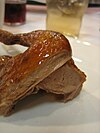 |
乳鴿 | 乳鸽 | jyu5 gap3 | rǔ gē |
| Roast suckling pig | 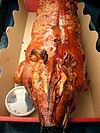 |
燒乳豬 | 烧乳豬 | siu1 jyu5 zyu1 | shāo rǔ zhū |
| Seafood with bird's nest |  |
海鮮雀巢 | 海鮮雀巢 | hoi2 sin1 zoek3 caau4 | hǎixiān quècháo |
| Shrimp with salt and pepper |  |
椒鹽蝦 | 椒盐虾 | ziu1 jim4 haa1 | jiāo yán xiā |
| Sour spare ribs |  |
生炒排骨 | 生炒排骨 | saang1 cau2 paai4 gwat1 | shēng chǎo páigǔ |
| Spare ribs with salt and pepper | 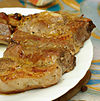 |
椒鹽骨 | 椒盐骨 | ziu1 jim4 paai4 gwat1 | jiāo yán gǔ |
| Squid with salt and pepper |  |
椒鹽魷魚 | 椒盐鱿鱼 | ziu1 jim4 jau4 jyu2 | jiāo yán yóuyú |
| Yangzhou fried rice |  |
揚州炒飯 | 扬州炒饭 | Joeng4 zau1 cau2 faan6 | Yángzhōu chǎofàn |
Dessert
[edit]After the evening meal, most Cantonese restaurants offer tong sui (糖水; táng shuǐ; tong4 seoi2; 'sugar water'), a sweet soup. Many varieties of tong sui are also found in other Chinese cuisines. Some desserts are traditional, while others are recent innovations. The more expensive restaurants usually offer their specialty desserts. Sugar water is the general name of dessert in Guangdong province. It is cooked by adding water and sugar to some other cooking ingredients.
| English | Image | Traditional Chinese | Simplified Chinese | Jyutping | Pinyin |
|---|---|---|---|---|---|
| Black sesame soup |  |
芝麻糊 | zi1 maa4 wu2 | zhīmahú | |
| Coconut pudding |  |
椰汁糕 | je4 zap1 gou1 | yēzhīgāo | |
| Double skin milk |  |
雙皮奶 | 双皮奶 | soeng1 pei4 naai5 | shuāngpínǎi |
| Mung bean soup |  |
綠豆沙 | 绿豆沙 | luk6 dau6 saa1 | lǜdòushā |
| Red bean soup |  |
紅豆沙 | 红豆沙 | hong4 dau6 saa1 | hóngdòushā |
| Sago soup |  |
西米露 | sai1 mei5 lou6 | xīmǐlù | |
| Shaved ice |  |
刨冰 | paau4 bing1 | bǎobīng | |
| Steamed egg custard | 燉蛋 | 炖蛋 | dan6 daan2 | dùndàn | |
| Steamed milk custard | 燉奶 | 炖奶 | dan6 naai5 | dùnnǎi | |
| Sweet Chinese pastry |  |
糕點 | 糕点 | gou1 dim2 | gāodiǎn |
| Sweet potato soup |  |
番薯糖水 | faan1 syu4 tong4 seoi2 | fānshǔ tángshuǐ | |
| Tofu flower pudding | 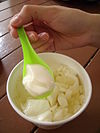 |
豆腐花 | dau6 fu6 faa1 | dòufǔhuā | |
| Tortoise Jelly |  |
龜苓膏 | 龟苓膏 | gwai1 ling4 gou1 | guīlínggāo |
Delicacies
[edit]Certain Cantonese delicacies consist of parts taken from rare or endangered animals, which raises controversy[according to whom?] over animal rights and environmental issues. This is often[according to whom?] due to alleged health benefits of certain animal products. For example, the continued spreading of the idea that shark cartilage can cure cancer has led to decreased shark populations even though scientific research has found no evidence to support the credibility of shark cartilage as a cancer cure.[7]
| English | Image | Traditional Chinese | Simplified Chinese | Jyutping | Pinyin |
|---|---|---|---|---|---|
| Bird's nest soup |  |
燕窝 | jin1 wo1 | yànwō | |
| Braised abalone |  |
燜鮑魚 | 焖鲍鱼 | mun6 baau1 jyu4 | mèn bàoyú |
| Jellyfish |  |
海蜇 | hoi2 zit3 | hǎizhé | |
| Sea cucumber |  |
海参 | hoi2 saam1 | hǎishēn | |
| Shark fin soup |  |
魚翅湯 | 鱼翅汤 | jyu4 ci3 tong1 | yúchì tāng |
See also
[edit]- Cantonese culture
- Chinese food therapy
- Dim sum
- Hong Kong cuisine
- List of Chinese dishes
- Macanese cuisine
- Restaurant industry in Guangzhou
References
[edit]- ^ Hsiung, Deh-Ta. Simonds, Nina. Lowe, Jason. [2005] (2005). The food of China: a journey for food lovers. Bay Books. ISBN 978-0-681-02584-4. p17.
- ^ Klein, Jakob A. (October 2007). "Redefining Cantonese cuisine in post-Mao Guangzhou". Bulletin of the School of Oriental and African Studies. 70 (3): 511–537. doi:10.1017/S0041977X07000821. ISSN 0041-977X. S2CID 146794802.
- ^ Civitello, Linda (23 March 2011). Cuisine and Culture: A History of Food and People. Wiley. p. 281. ISBN 9781118098752.
- ^ Editorial Team of Hong Kong Economic Journal (May 2021). "舌尖上的中國:八大菜系由來 [The Taste of China: The Origin of Eight Great Traditions]". Hong Kong Economic Journal.
- ^ L, Ellen. "Shunde Style Sashimi 順德魚生". Retrieved 6 December 2022.
- ^ Wordie, Jason (2002). Streets: Exploring Hong Kong Island. Hong Kong: Hong Kong University Press. ISBN 962-209-563-1.
- ^ Wolfe, Marilyn J.; Wolf, Jeffrey C.; Cheng, Keith C.; Ostrander, Gary K. (1 December 2004). "Shark Cartilage, Cancer and the Growing Threat of Pseudoscience". Cancer Research. 64 (23): 8485–8491. doi:10.1158/0008-5472.CAN-04-2260. PMID 15574750. Archived from the original on 19 July 2012. Retrieved 11 June 2012 – via cancerres.aacrjournals.org.
Further reading
[edit]- Eight Immortal Flavors: Secrets of Cantonese Cookery from San Francisco's Chinatown, Johnny Kan and Charles L. Leong. Berkeley, California: Howell-North Books, 1963



